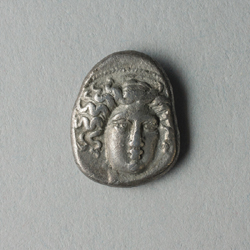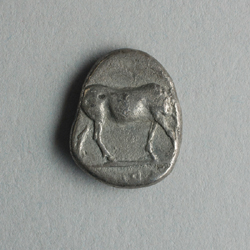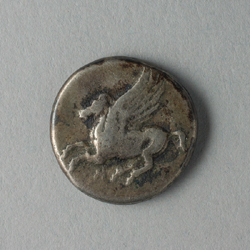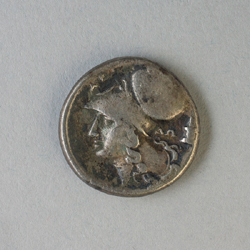Wandering Greeks (7 page)
Authors: Robert Garland

No detailed account of the return of the Heraclidae has come down to us in literature. The legend is first alluded to by Homer, who makes an anachronistic reference to Dorians inhabiting Crete during the heroic age (
Od
. 19.177). The earliest author to make explicit reference to it is Tyrtaeus (fr. 2.14
IEG
). Tyrtaeus is also the first to mention the three Dorian tribesânamely, the Dymanes, Hylleis, and Pamphyloiâinto which those claiming descent from Heracles divided themselves (fr. 19.8
IEG
). Two centuries later Herodotus briefly mentions the first unsuccessful assault of the Heraclidae on the Peloponnese following the death of Eurystheus, Heracles's tormenter (9.26). Thucydides' account, written perhaps a generation later, is more explicit (1.12.3): he claims that sixty years after the fall of Troy the Thessalians expelled the inhabitants of a town called Arne, who then migrated south and
settled in Boeotia. Then, twenty years later, the Dorians and the Heraclidae (he treats them as two separate peoples) seized the Peloponnese. Thucydides traces the origins of the upheaval to factional squabbles that were generated by the delayed return of the Greek army from Troy. Irrespective of whether the Trojan War was a historical event or not, his awareness of the consequences of an extended war in terms of population movement is impressive. The earliest known account of the “return,” no longer extant in its original form, was written by Ephorus in the fourth century (
FGrH
70 F 117).
It has been convincingly suggested that the legend of the return of the Heraclidae developed as a way of “providing the emergent states in the Peloponnese with a respectable pedigree” (Hooker 1979, 360). As such, it marks an important moment in the history of ideas, by illustrating how the experience of migration constitutes a way of affirming and consolidating a collective sense of national identity, since a belief in common descent contributes toward the development of group formation. Irrespective of the degree to which the myth of the return has any basis in factâa subject that continues to be keenly debated by scholarsâits contribution to a sense of common purpose can hardly be exaggerated. For the Dorians it was what Hall (1997, 185) has aptly dubbed “a social reality,” and that is what mattered in the end.
Claiming descent from a refugee movement was by no means exclusive to the Dorians. According both to Genesis and to modern paleontologists, we are all descended from refugees. In fact the earliest human encounter with reality in Genesis is symbolized by exile. The Hebrews, too, claimed descent from wanderers, though in their case their wandering was prompted both by a yearning to escape servitude and by a desire to worship the Lord unimpeded. It is worth noting, however, that their “return” does not seem to have had the same emotional intensity for the Dorians as the Exodus event did (and does) for Jews today. The chief festival for those of Dorian identity was the Karneia, which was celebrated in honor of Apollo Karneios. Unlike the Jewish festival of Pesach, however, the Karneia seems not to have been a festival of liberation, though the ritual of carrying model boats that formed part of it may have commemorated the crossing into the Peloponnese from
Antirhion to Rhion. The Romans, too, saw themselves as a people descended from refugees and deportees.
From the period of the Persian Wars onward the Athenians, in contradistinction to the Dorians, maintained that they had always inhabited the same land. The earliest reference to this belief occurs in Pindar's
Second Isthmian Ode
(dated ca. 470), in which the poet asserts that the Athenians were descended from an early king called Erechtheus, who was born from the earth (2.19). Herodotus recognized the force of the claim by having the Athenian envoy to the Sicilian tyrant Gelon boast (7.161.3; cf. 1.56.2): “We, the Athenians, are the most ancient
ethnos
[people, ethnic group] and the only Greeks who are not
metanastai
[refugees].” Thucydides, speaking in his own voice, declared that Attica “was occupied by its original inhabitants” (1.2.5). He went on to explain that this was due to the poverty of its soil, which had failed to attract migrants from abroad and thereby (blessedly) eliminated the possibility of internal strife. In the Funeral Speech, too, he has Pericles remind his audience that they were descended from ancestors “who always inhabited the land without interruption in a succession of generations” (2.36.1). The belief features in Euripidean tragedy. Praxithea in Euripides' lost play
Erechtheus
proudly declares (fr. 50.7â10 Austin): “We are not a people brought together from elsewhere by the fall of dice like the inhabitants of all other cities, but we are
autochthones
[seeded or born from the ground].” Elsewhere, however, Euripides pointed out the absurdity of autochthony as literally understood, notably when he has Xuthus in the
Ion
assert categorically, “The earth does not bear children” (l. 542). Its absurdity notwithstanding, it became commonplace in the fourth century, notably in what Cohen (2000, 83) calls “the platitudinous banalities of encomia delivered at public funerals ⦠[which] produced a genre that strung together formulaic tales to reify state ideology and mythological tradition.” The following is an example, written no doubt to order, by the metic Lysias (
Epitaph
. 17):
The origin of the Athenian way of life is lawful. Most people derive from a mixture of groups and have taken possession of foreign soil by expelling
others, whereas the Athenians are autochthonous and their fatherland is their true mother.
To conclude, no people chooses a myth of origin in order to feel bad about themselves, though it may be that the Athenians had an ideological edge over the rest in boasting of autochthony. In so doing, as Lysias indicates, they were making a case for ethnic purity. In analyzing ancient beliefs about autochthony, Detienne (2001, 55) trenchantly observes, “We provide ourselves with the means of better understanding those murderous throbbings of identity which pulse in the human societies of yesterday, today, and tomorrow.”
1
Discussion of the fugitives Bellerophon, Tlepolemus, Phoenix, Patroclus, and Theoclymenus, all of whom appear in the
Iliad
, is reserved for
chapter 8
.
3
THE SETTLER
Why the Greeks Settled Abroad
The Greek diaspora is most conventionally understood primarily in terms of what I shall call settlement abroad.
1
From the twelfth century BCE onward there is no evidence of any significant influx of population into mainland Greece. However, that period did witness a considerable migration from the mainland into areas previously uninhabited by Greeks. The details are hazy, but it seems that what scholars call the Ionian migration took place in the early Dark Age, around the eleventh and tenth centuries, and was in the nature of a mass exodus. It led principally to the settlement of the Aegean islands and the (now Turkish) Western Anatolian coastline in the region between Smyrna and Miletus. Some time later Aeolian Greeks living in Thessaly settled in the region north of Smyrna, while Dorians from the Peloponnese settled to the south of Miletus.
A second wave of settlement occurred in the archaic period and lasted from around the middle of the eighth century to the end of the sixth, though, as Hall (2002, 92) and others have noted, archaeology has now brought to light “a far more continuous sequence of contact and
encounters between Greeks and non-Greeks.” To the extent that we can measure difference between the two “movements,” the one that began in the eighth century was more concentrated, at least in the number of settlements. First Sicily and southern Italy were settled, then the coast of Macedon and Thrace, followed by the Black Sea region, and then Cyrenaica in Libya, southern coastal France, and southeast Spain. The
mêtropoleis
(mother-cities) that sent out the largest number of pioneering ventures in the archaic period include Miletus (36 settlements), Corinth (13), Eretria (8), Chalcis (7), Megara (5), Thasos (5), Phocaea (4), Sybaris (4), and Syracuse (4).
2


FIGURE 3
Silver
drachma
from Larissa, the chief city in Thessaly, ca. 365â44. The obverse depicts the head of the nymph Larissa, for whom the city was named. The reverse depicts a horse. An inland city surrounded by mountains and rich in pastureland, it was famous for its horses. The legend in the exergue reads (
LARIS
)
AIÃN.
Larissa was the first Thessalian city to strike coins. Polyperchon II,
tagos
(federal commander) of Thessaly, exiled many of its citizens in 370/69.
In the course of the archaic and classical periods, 279 settlements known commonly as
apoikiai
(literally “homes away from home”) were founded in what today are Albania, Bulgaria, Egypt, France, Georgia, Italy, Libya, Romania, Russia, Sicily, Spain, Turkey, and Ukraine. Some 88 of them were secondary foundationsâthat is, founded by a mother-city that had itself been settled by a mother-cityânotably those in Sicily and
southern Italy. The movement took the form it did because the Mediterranean constituted “a milieu of interlocking routes onto which the coastlands and harbours faced” (Horden and Purcell 2000, 11). Though most settlements were founded overseas, some were established in adjoining territory, such as Acrae, Camarina, Casmenae, and Tyndaris, which Syracuse founded. The scale of migration to southern Italy was such that later historians referred to the region as
Megalê Hellas
(
Magna Graecia
in Latin), meaning Great Greece.
The later movement came to an end only when all the best coastal sites had been occupied. It would hardly have succeeded were it not for the fact that Greek traders were on the lookout for mercantile profit. This in itself, however, hardly explains why so many Greeks came to settle permanently abroad. One theory, less popular than it used to be, is that many settlements were founded in response to overpopulation and land hunger. This, too, is what some later Greeks believed. Plato spoke of “the masses having grown too numerous for the country's food supply” in relation to Crete (
Laws
4.707e), and of “an excessive abundance of population” in general, viz a population that exceeded his recommended maximum of 5,040 citizensâthat is, some 20,000 persons in all (5.740de). Archaeological evidence indicates that a handful of settlements, including Pithecusae and Syracuse, expanded very rapidly, partly perhaps in response to a demographic crisis. Paradoxically, however, there is no conclusive evidence of overpopulation in those parts of Greece that dispatched settlements in greatest numbers, viz the Megarid, Corinthia, Achaea, and Euboea, whereas those regions where it is inferred that substantial demographic growth did occur, notably Attica and the Argolid, did not send out any colonies (Whitley 2001, 125â26). Another explanation is resource fluctuations. The crisis on Thera that led to the settlement of Cyrene, for instance, was prompted by seven years of drought (see later). Political motives should not be ruled out either, notably in the case of settlements sponsored by tyrants. Nicolaus of Damascus (fl. first century BCE) claims that Cypselus, tyrant of Corinth, dispatched his political enemies as settlers to Leucas and Anactorium in ca. 630, “so that he could rule those who remained more easily” (
FGrH
90 F 57.7). In conclusion, though overpopulation
and land hunger may have been prominent factors, each community had its own specific mix of reasons for sending pioneers abroad.


FIGURE 4
Silver
statêr
from Anactorium, a coastal city in Acarnania, ca. 300â250. The obverse depicts the winged horse Pegasus, which was caught by Bellerophon while it was drinking at the fountain of Peirene in Corinth. The reverse depicts the head of Athena (or less likely Aphrodite) wearing a Corinthian helmet, probably because it was Athena who gave Bellerophon the magic bridle used to capture the winged horse Pegasus. Anactorium was founded by settlers from Corinth in ca. 630, and the coin type imitates that minted by Corinth. The Corinthians captured the city in 432 and sent out new settlers. In 425 the Athenians and their Acarnanian allies seized Anactorium after it had been betrayed from within (Thuc. 4.49). The site has yet to be excavated.
